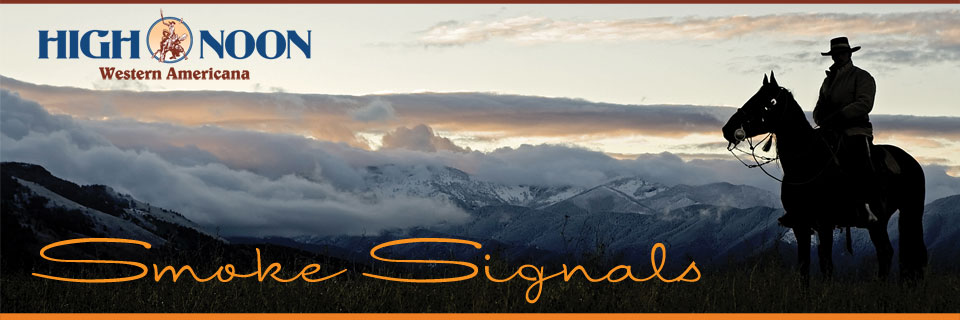
![]()
Stuff I Know About Indian Camp Blankets
By Barry Friedman
While still doggedly pursuing my theory that Brian Lebel is Arnold Schwarzenegger's oldest love child, I've decided to take a momentary step back from that twisted tale to further educate Smoke Signals readers on my specialty, American Indian trade and camp blankets.
Certainly nobody can forget my March article that dealt with the history of the American Indian trade blanket. Everybody's still buzzing about that one and now here I am about to explain Indian camp blankets! I can hardly imagine your excitement and would give anything to be in your shoes and/or Lucchese's.
You'll recall that the fine wool geometric pattern blankets produced by Pendleton Woolen Mills and their competitors instantly became a staple of North American Indian life and remain so today. Pendleton is the only surviving pioneer trade blanket manufacturer and was the only mill that specifically went into business to create blankets for the Indian market. They manufactured their first blanket in 1896 and from the beginning made a very high quality product that commanded a good price.
By the 1920s Pendleton's business was booming and their blankets retailed for $8 to $10. That was a very strong price considering a modest home of that time could be bought for several thousand dollars...quite a bit more than my home is worth in this economy, but I'm not bitter about it and am sure my shattered nerves and accompanying rash and twitching are only temporary.
It was not only Indians who loved trade blankets. Huge numbers were being sold to Anglos who wanted to add an Indian touch to their homes and much-needed warmth to their cars. The first real car heater wasn't available until the 1929 Ford Model A and let's face it, you didn't know that until this very moment. Now you know and quite frankly, I think you're feeling pretty cocky about yourself right now.
There's more. While the woolen mills fought each other for customers the largest cotton blanket manufacturer in the world began to flex its muscles. The Beacon Manufacturing Company of New Bedford, Massachusetts and later Swannanoa, North Carolina reasoned that if wool Indian blankets were selling well at $10 then similar patterns in cotton should move even quicker retailing for a dollar or two.
While Beacon sold every possible style of bed blankets from simple solids to Art Deco it was their Indian patterns that soared in the 1920s. Native Americans had no use for them at all - only a wool trade blanket was deemed worthy - but giant retailers like W.T. Grant and Penney's sold millions of them. In its peak production years Beacon maintained an inventory of over two million blankets. Their primary rival was Esmond Mills, a Rhode Island manufacturer that also did a thriving business in Indian patterns.
Beacon's pure cotton production ended with a switch to cotton/synthetic blends in the 1940s and these later blankets are not of interest to serious collectors. It is the 100% cotton blankets of the 1920s and 30s that are so eagerly sought.
These textiles are most often referred to as either Beacon blankets or camp blankets. There's no great mystery why they're called camp blankets. Many summer camps had Indian names and any self-respecting kid would want to show up with their very own Beacon Indian blanket.
Personally, I spent every summer in Ortonville, Michigan at Camp Nahelu, which was owned by my Uncle Stanley who knew zero about Indians and precious little about much else. My father once gave him a cured ham and with a seriously stricken look Stanley asked him how long it'd been sick. At his camp the main activity was making lanyards apparently in the hope that one day they'd be gobbled up by the ever-growing whistle industry.
But I digress. It was virtually impossible to copyright blanket designs and Beacon stole wantonly from the woolen manufacturers and further infuriated them by selling at one tenth their price. Their own designs were dazzling and the very best were their ombre blankets. In an ombre pattern the colors blend into each other and are so labor intensive that the woolen mills never manufactured them at all. Ombre patterns are at the top of any savvy collector's want list and unique examples can fetch over a thousand dollars. Such a blanket illustrates this article and graces the collection of Jon Stuart, the only Norwegian consulate with whom I am personally acquainted.
Beacon and Esmond blankets also trump their wool trade blanket cousins in one other important area. Moths don't particularly care for cotton while their love for wool is legendary. Personally, I'd like to see a little more bran in their diets.
Barry Friedman is a self-proclaimed deeply disturbed man and the author of Chasing Rainbows: Collecting American Indian Trade and Camp Blankets. His Web site is at www.barryfriedmanblankets.com and he particularly recommends his Blanket Of The Month page and IBC Root Beer.
If problems with website occur, please contact the webmaster. Site designed by Ireland Graphic Design.
